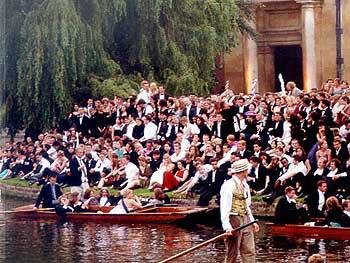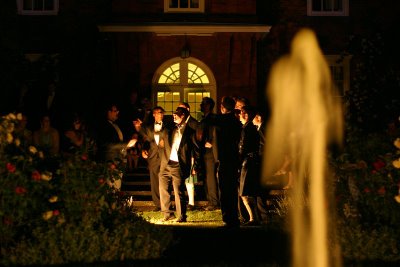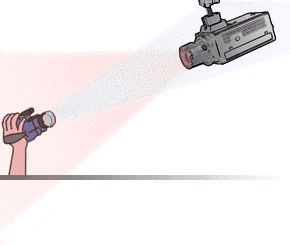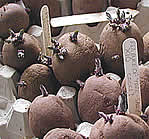 A while ago, my friend Rob gave me two eggboxes full of chitted potatoes to plant, and some envelopes of vegetable seeds, too. A marvellous gift. The potatoes have been sitting under the windowsill in the pantry for a long while. And this evening I planted them in the garden. Finally. What a relief to put them in the ground and cover them over. I've been fractious and inactive and just generally morose all day, but no longer. My fingernails are black with loam and my fingers fizzy with nettle stings. My back hurts, because I've not dug over ground for a long while, and have rather forgotten how to do it, but ah, the satisfaction. Even with the fizzy fingers and the backache, I'm suddenly so very contented. Potatoes are the best kind of present.
A while ago, my friend Rob gave me two eggboxes full of chitted potatoes to plant, and some envelopes of vegetable seeds, too. A marvellous gift. The potatoes have been sitting under the windowsill in the pantry for a long while. And this evening I planted them in the garden. Finally. What a relief to put them in the ground and cover them over. I've been fractious and inactive and just generally morose all day, but no longer. My fingernails are black with loam and my fingers fizzy with nettle stings. My back hurts, because I've not dug over ground for a long while, and have rather forgotten how to do it, but ah, the satisfaction. Even with the fizzy fingers and the backache, I'm suddenly so very contented. Potatoes are the best kind of present.
The Troad is a fine field for conjecture and snipe-shooting, and a good scholar may exercise their feet and faculties to great advantage upon the spot
Monday, April 24, 2006
Potato therapy
 A while ago, my friend Rob gave me two eggboxes full of chitted potatoes to plant, and some envelopes of vegetable seeds, too. A marvellous gift. The potatoes have been sitting under the windowsill in the pantry for a long while. And this evening I planted them in the garden. Finally. What a relief to put them in the ground and cover them over. I've been fractious and inactive and just generally morose all day, but no longer. My fingernails are black with loam and my fingers fizzy with nettle stings. My back hurts, because I've not dug over ground for a long while, and have rather forgotten how to do it, but ah, the satisfaction. Even with the fizzy fingers and the backache, I'm suddenly so very contented. Potatoes are the best kind of present.
A while ago, my friend Rob gave me two eggboxes full of chitted potatoes to plant, and some envelopes of vegetable seeds, too. A marvellous gift. The potatoes have been sitting under the windowsill in the pantry for a long while. And this evening I planted them in the garden. Finally. What a relief to put them in the ground and cover them over. I've been fractious and inactive and just generally morose all day, but no longer. My fingernails are black with loam and my fingers fizzy with nettle stings. My back hurts, because I've not dug over ground for a long while, and have rather forgotten how to do it, but ah, the satisfaction. Even with the fizzy fingers and the backache, I'm suddenly so very contented. Potatoes are the best kind of present.
Swifts

Swifts are probably the coolest birds in the world. I could go on for hours about them. Swifts eat, sleep, breed and feed on the wing. Once youngsters leave their nests they won't land again for two years. Their wings are so long that swifts flap helplessly, stranded like beached fish, should they land on the ground. Their tiny feet look like mouse paws. Their tiny beak hides a gape as huge and scary as a basking shark's, designed to scoop insect plankton from the air for hours and hours at a time. Did you know that young swifts can hibernate during periods of heavy rain? That swifts will fly a thousand miles to avoid a depression and then return when the rain has stopped? Oh, how unbelievably, bewilderingly weird they are.
This house is a college house, one of forty or so in a central Cambridge square. Swifts arrive back from Africa in May. Straightway the sky is a riot of shrill, particulate swift calls. The Doppler effects you hear as screaming swifts hurtle past make you feel you're living in a canyon. A pair nests three doors down in a hole under the eaves of the Butler's house. They fly into a hole smaller than the top of a coffee cup at full speed. Thump.
 By the end of the month, Birdle (whose sleeping cage is next to the window) practises his swift impersonations early every morning. I'm not looking forward to that much. It's loud. And (bless) he's not very good. He gets the piercing quality, believe me, and the descending cadence, but he misses the complexity of the call. Swifts live so fast, their calls are incomprehensible to humans, but if you slow them down, you can hear the melody. They're not calls; they're songs. Swifts live so fast that one apiarist, the story goes, enraged by the swifts zooming past his hives, managed somehow to shoot a couple. He wanted to prove they were eating his bees. He was dumbstruck to discover they'd been preferentially snapping up stingless drones, not worker bees, at full speed. That's how fast they live.
By the end of the month, Birdle (whose sleeping cage is next to the window) practises his swift impersonations early every morning. I'm not looking forward to that much. It's loud. And (bless) he's not very good. He gets the piercing quality, believe me, and the descending cadence, but he misses the complexity of the call. Swifts live so fast, their calls are incomprehensible to humans, but if you slow them down, you can hear the melody. They're not calls; they're songs. Swifts live so fast that one apiarist, the story goes, enraged by the swifts zooming past his hives, managed somehow to shoot a couple. He wanted to prove they were eating his bees. He was dumbstruck to discover they'd been preferentially snapping up stingless drones, not worker bees, at full speed. That's how fast they live.To my great joy, I've been offered some experimental swift nestboxes through the agency of Action for Swifts. You know, living in a college house is sometimes simply the best thing in the world. I asked them if I could put up two nestboxes under the eaves. They said they'd send round a builder to do it for me. I love my college.

I want swifts nesting over my bedroom window!
Sunday, April 23, 2006
Orford Ness
Normally, of course, thermals bubble up over the landscape and grow cumulus clouds as they go, so you can see where they are. On a blue thermal day, there's not a single cumulus growing or dying; no clouds at all. Just invisibly rising air.
I spent this blue thermal day getting lightly sunburned walking around Orford Ness with a student who's working on this place for her dissertation. It was warm enough that the nuclear testing pagodas wobbled in the haze coming off the beach, and the water-flashes in the grazing marsh were packed with dunlins stopping off to refuel with muddy invertebrates on their way north. By midday they were all gone.
Of course I didn't bring a camera, so I can't show you what Orford Ness looks like in white sunlight on a blue thermal day, but here are some from last autumn, when Orford is full of mist-nets and bird-ringers and tired migrant passerines. Orford Ness is one of the strangest places in the whole of East Anglia, which (along with the Forest of Dean) is one of the strangest places in the whole of Britain. Click on the pictures to make them bigger...

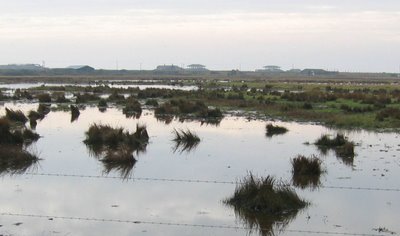
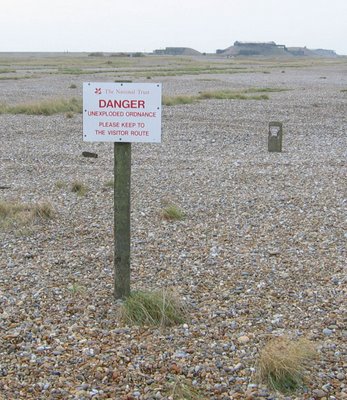


Thursday, April 20, 2006
This month's search terms
- Alexander McQueen Singular Oil
- Chukar partridge black band over eye orange beak
- Care of Whooper Swan
- "Jesus College" Oxford
- Shampoo advertisements in the 1990s
- bird flu blogspot
- Dollys large breast
- Mythical Phoenix
- Icelandic workmates on 18 century photos
- 70 slangs
- Hawking with merlins
- A hunting sparrowhawk
- u2 "laughing babies"
- binoculars shop in sharjah
Now you don't
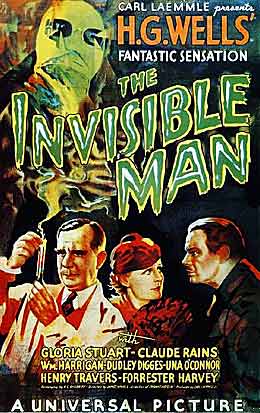
I was in Hampshire the other day, staying with my parents for Easter. I walked up to a local hill, Saturday evening. Nice place: Woodland Trust site, an arable farm turned back to hawthorn scrub, young wood, and chalk grassland. I thought I was walking there to see if the turtle doves had returned. They weren’t here ten years ago, but the scrub has brought them back, and I love turtle doves. Later I realised that wasn’t the whole reason. I also wanted to be unlocatable: a very different desire, but as strong nonetheless. It’s nice to know, sometimes, that no-one on earth knows where you are.
 No turtledoves, but I watched a blackcap bathing in a blank tractor-rut pool. I waited. Because bird-bathing is contagious. And soon two great tits, two blue tits and a male chaffinch joined it. A little flock of exuberant, wet birds. Brilliant.
No turtledoves, but I watched a blackcap bathing in a blank tractor-rut pool. I waited. Because bird-bathing is contagious. And soon two great tits, two blue tits and a male chaffinch joined it. A little flock of exuberant, wet birds. Brilliant.There are a couple of old coverts and shelter-belts on the reserve, and I walked into the top covert (larch, oak, woodpigeon roost) and threaded my way through along a thin deer-printed path of sticky boulder clay. Knelt down at the point where the path dried as it left the wood, and then sat back, very carefully, onto larch twigs, moss and pigeon feathers. A few elder twigs broke up my outline, but on the chalky grassland before me, two or three rooks were spooked and flew away. I wasn’t exactly invisible—but I intended to become so.
You often hear that sitting very still is enough to become invisible in a landscape. Balderdash. Well, I’ve never found it enough. You can’t become invisible merely by being still. You have to will yourself into invisibility.
I’m sitting on the ground, then, in the wood, my legs crossed and my back straighter than it ever is in a chair, letting my face become a mask as I become invisible. I think I sat there for at least half an hour, maybe an hour, without moving my face once. Try it. Try being expressionless for an hour. It is very interesting. Of course I moved my eyes. I watched larks and rooks and clouds and the scuts of rabbits as they crossed my field of view—it is painful for eyes and brain, right at the edge, in peripheral vision—and then gazed back on the field in front. Everything behind me was invisible. It is easy to forget you have a partial view. It’s not even really a semicircle.
So: just under a semicircle of vision. Everything behind me is sound. The click of larch-cones cooling as the temperature drops; bird-song in stepped distances (close birds, far birds, distant birds) and the sound of woodpigeons clattering in the trees as they come into roost. This split: sight in front, sound behind, is extraordinary. You can build a whole world from two entirely different semicircles: vision in front, noise behind, and it holds together seamlessly.
And, as always happens when you sit still, for a very long time, in the same place, the land ceases to be a map. You stop seeing it as something to navigate, move across, and it turns into something else. A place for other things. Other things' maps. That’s a bit hard to explain abstractly. I’m watching the rabbits, for example, forty, fifty feet in front of me, chasing each other, courting, grazing, running in alarm as a buzzard sails over, and I started thinking of the rabbits’ maps, not my own. And the buzzard’s maps, and the maps of moths. Like some crazed ecologist; all the different organisms in this little chalk rise, with its woods and broken flints and fences and blackthorn craters and rabbit-cropped turf; all of them have their own worlds here. Of course, writing it down comes across as trite, and a philosophical nonsense. But the experience, the intuition, in the field, is a different matter.
I’ve tried to describe this going-invisible thing many times, and people often mistake it for some radical derealisation. They think my world collapses into shapes and angles and empties of meaning. Like some strange narcotic-induced reverie. No! I say. No, no no! And of course, Barry Lopez puts it perfectly:
Hunting in my experience—and by hunting I simply mean being out on the land—is a state of mind. All of one's faculties are brought to bear in an effort to become fully incorporated into the landscape. It is more than listening for animals or watching for hoofprints or a shift in the weather. It is more than an analysis of what one senses. To hunt means to have the land around you like clothing. To engage in a wordless dialogue with it, one so absorbing that you cease to talk with your human companions. It means to release yourself from rational images of what something "means" and to be concerned only that it "is". And then to recognize that things exist only insofar as they can be related to other things. These relationships—fresh drops of moisture on top of rocks at a river crossing and a raven's distant voice—become patterns. The patterns are always in motion. Suddenly the pattern—which includes physical hunger, a memory of your family, and memories of the valley you are walking through, these particular plants and smells—takes in the caribou. There is a caribou standing in front of you. The release of the arrow or bullet is like a word spoken out loud. It occurs at the periphery of your concentration.Oh, that's so good. And there’s much, much more to be said about the phenomenal world of hunting. It’s hard to write about hunting at all, because there are as many different types of hunting as there are types of marriage. Another time, yes—stumblingly, not like Lopez.
But what is clear, and what is worrying, is this: once you’ve learned how to become invisible, it becomes second nature. And it’s hard not to do it all the time. And because you can do it while you’re walking, too, it can be very dangerous. People actually walk into you in the street, as if they didn’t see you. I’m not kidding. Really. Yesterday. I was thinking hard about work, walking back from a meeting, and then about nothing at all, and blam! Three people, one after the other, within the space of fifty feet, walked into me. I have a bruise on one arm to prove it. Hey ho.
Drunken excess
So many things to write about! A visit to the British Antarctic Survey recently, to an extraordinary meeting on climate change; and a long post on what sitting still in a landscape does; and some personal notes on hunting, and on being invisible. But these are all important, and what I’m going to write now isn’t.
Because I was asked about May Balls the other day, by an American friend. I understand the confusion. Here, in the UK, we’re mystified by this “Spring Break” business and the “High School Prom” and “Homecoming” things. What? Huh? When I was a child we had “school discos”’—theatres of pain to awkward, too-tall and terminally uncool kids like the young Pluvialis.
We don’t have discos at this university. We have May Balls. May Balls are why we will all, all of us here, be first against the wall when the Revolution comes.
May Balls happen after the examinations, in the “drink until you die" stage of the undergraduate academic calendar, just after the exams. In June. Garb? Oh, Black tie, white tie, you know, ballgowns, uniforms, blah. Enormously popular they are too. I have been to a couple, both with much-loved friends: without them I'd probably have been terrified, and tried to escape by the river route.
Note: security at these events is serious. They don’t actually have armed guards patrolling the banks of the river Cam to shoot frogmen gatecrashers with suits and bow ties under their drysuits, a la Roger Moore. And I don’t remember razor wire or machine-gun emplacements. But almost. It’s still impossibly cool to gatecrash a May Ball, of course, and I’m still embarassingly proud that I got in free a couple of years ago as a guest of one of the bands. Bless you British Sea Power.
Often these balls have themes. This can be, and generally is, particularly excutiating. The big colleges don’t, of course. It’s generally the smaller colleges who need to Theme their balls. The organising committee does its very best to transform the College and its grounds into a wonderland, something heavenly and extraordinary and unrecognisable. Look! We’re in eighteenth-century Paris! Or New Orleans! Or (groan) Carnival! I wish there’d be some more creative thinking in this regard. I want to go to a ball themed around oceanography or Tolstoy or an 1950s agricultural show.
Note to Ball organisers. I know it might sound a good idea at the time to have mixed themes (e.g. Las Vegas meets the Arabian Nights) but it don’t work. And one of the most painful truths about these displays of conspicuous consumption is that they're a fast, accurate indicator of the financial and academic status of the College concerned. In terms of ‘transporting one to a different time and place’, stapling brown paper on the walls and sticking playing cards all over it it is not really in the same league as a wall of lasers playing through a fog bank of dry ice. One makes you feel you’re off the Grand Banks on acid; the other is embarrassing. Like watching someone else's child forget her lines at a school play. Actually, both of these experiences encourage drunken excess, so I guess there’s not much to choose between them.
The biggest balls are high-octane, faintly eighteenth-century creations: Fragonard, Pleasure Gardens, um, Great Gatsby. I've been to one of these. A breathlessly still summer evening, with a scraped wet silk sky, and fire-eaters in the courtyards. Amazing. Mind-numbing in its medieval largesse. Hot air balloons! Live Camels! As much alcohol as you can drink! Food, food, food! Fireworks!
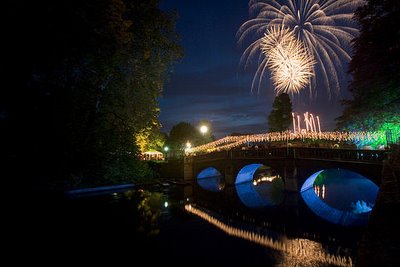
In the cold light of day, however, a Puritan horror strikes. Tickets to these things cost a fortune. Your Local Education Authority isn't there to pay for a night of getting rat-arsed, breaking heels, eating free food, watching bands of a quality entirely dependent on the richness of your college (the larger ones tend to have chart-topping indie acts, the poorer ones chart-topping indie acts from five years ago)....
Crowds of drunken undergraduates with loosened bow-ties flapping in the wind ram each other in displays of repressed homosexuality on the dodgems. Punts filled with ice and champagne melt. A light shower of rain ruins all the bespoke ball-gowns at three in the morning. The Fire-eaters go home. Dawn pales the sky and the wreckage is revealed. Litter, glassware, small clumps of inconsolable drunken students who've been dumped or upstaged during the night hugging their knees under willow and plane trees. And everyone staggers home at 6AM after cheering for a 'survivor's photo' and watching a parachute drop.
Last year I went out early one June morning, binoculared and booted, on my way out of town for a birding trip. Across the causeways and paths, under willow trees and crossing roads, were long, straggling lines of exhausted people in evening dress, generally silent, often barefoot, making their way through the mist coming up from the river, wincing slightly in the breaking sunlight. It was the most surreal and beautiful vision; apocalyptic and calming all at once, like a beautifully-written science fiction novel. Which, come to think of it, is what Cambridge is like all the time.
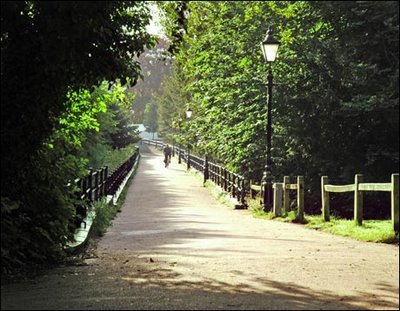
Wednesday, April 19, 2006
Monday, April 17, 2006
I have of late
- an old post on BLDGBLG on the ultimate in military environmentalism, soil bombing
- and the impossible romance of recording space weather:
- Stephen Bodio on Intelligent Design, and a priceless piece of Creationism on Objective Ministries, a perfectly-realised, heart-stoppingly ferocious satirical site
- and oh, this craftsman's site is bewitching; I so nearly blew hundreds of dollars here while living in Boise
- Jim Crace's Digested Reads are splendid, and this one in particular sums up everything there is to know about this member of the glitterati (nb: is the singular glitterato?)
Monday, April 10, 2006
Bird Flu Two
Pluvialis was vindicated! It turned out, later, that our John Doe swan was a Whooper, after all. Oh, how much I agree with this letter-writer:
It is of concern that those involved seem particularly devoid of any competent ornithological advice and expertise if they require a DNA test to tell a Mute from a Whooper swan–a task any knowledgeable ornithologist would complete with certainty in three minutes–even with the bird's head missing and partly decomposed.What has happened to our environmental literacy? Julian Huxley would have had a fit. And if a 10km surveillance zone is laughable for a Mute swan, it's beyond bizarre for a species that flies between England and Iceland in around twelve hours. The connections between place, ecological understanding, epidemiology and policy have become absolutely incomprehensible.
BirdLife got very grumpy about all this. As well they might. Slack identification of the species involved, they say, have held back studies of the aetiology of bird flu worldwide. Alas, the BBC is not helping with our training of ecological observers. According to them — Bird flu experts' wildfowl watch — these are the species we should watch out for as potential carriers of bird flu: Bewick's swan, Mallard, Pintail, Pochard, Shoveler, Teal, Tufted Duck, White-fronted goose, Whooper swan and Wigeon.
It sounds admirable. And to help the public, the BBC gives us little drawings to aid our identification of these deadly wildfowl.
Aaaargh! Here are the BBC's guides to identifying possible flu-carrying birds. I've added photos of what they actually look like, in real life.
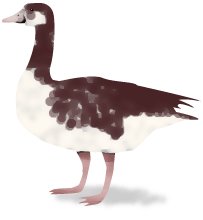


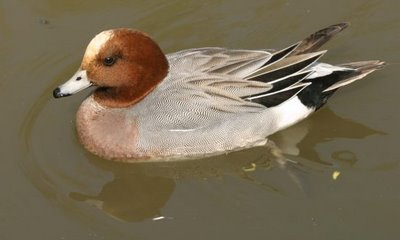
Oh, I know, yes, I'm being picky. It's because I've spent a lot of time working on strategies of bird identification, perhaps. But, my god, they really are rubbish. Should I really be so irritated? Does anyone else share my feeling that this kind of environmental illiteracy, from government and national broadcaster alike, is more than depressing? Is terrifying?
Bird Flu One
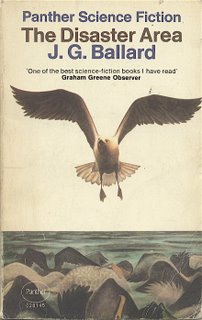 At dawn the bodies of the dead birds shone in the damp light of the marsh, their grey plumage hanging in the still water like fallen clouds. Each morning when Crispin went out on to the deck of the picket ship he would see the birds lying in the creek and waterways where they had died two months earlier, their wounds cleansed now by the slow current, and he would watch the white-haired woman who lived in the empty house below the cliff walking along the river. Along the narrow beach the huge birds, larger than condors, lay at her feet. As Crispin gazed at her from the bridge of the picket ship she moved among them, now and then stooping to pluck a feather from the outstretched wings. At the end of her walk, when she returned across the damp meadow to the empty house, her arms would be loaded with immense white plumes.
At dawn the bodies of the dead birds shone in the damp light of the marsh, their grey plumage hanging in the still water like fallen clouds. Each morning when Crispin went out on to the deck of the picket ship he would see the birds lying in the creek and waterways where they had died two months earlier, their wounds cleansed now by the slow current, and he would watch the white-haired woman who lived in the empty house below the cliff walking along the river. Along the narrow beach the huge birds, larger than condors, lay at her feet. As Crispin gazed at her from the bridge of the picket ship she moved among them, now and then stooping to pluck a feather from the outstretched wings. At the end of her walk, when she returned across the damp meadow to the empty house, her arms would be loaded with immense white plumes.from Storm-bird, storm-dreamer by J.G. Ballard (1967)
Friday, April 07, 2006
Notebook cocaine
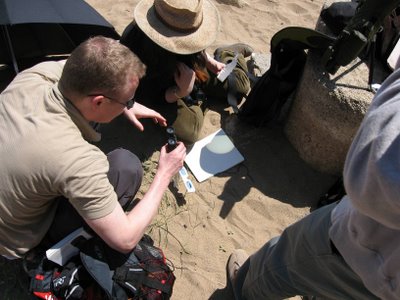
We all want to say "No! I don't care that Hemingway and bloody Bruce Chatwin used these books! I don't care about the history! I'm not impressed! I buy them because they're functional" But it's probably rubbish. Because this morning, when I found grit and sand in my Moleskine's back pocket and pages, and examined the strange sand-scars all over its covers, I felt that it wasn't really an inconvenience; more some kind of heritage event. "Ah, sand from the 2006 Eclipse in my Moleskine Notebook" I thought, grandly. Ptoo.
Thursday, April 06, 2006
Ha ha ha 2
Oh, but it's fantastic. I've removed the embedded player, but you can watch it here.
Losing my marbles
I'm telling you this because I was afforded a rather scary insight into the imperial mindset of old Thomas the other day. My friends and I had driven down the forested coast of southern Turkey to the ruined city of Anamurium, once a thriving — well, the usual story; raided by Arab corsairs in the 7th century, it's now a Byzantine ghost town.
It was deserted. And we set off to explore it. That is, explore in the way day-trippers do; have a clamber about some ruins and then think about lunch. Anamurium, though, is a vastly special place. So our offhand plan, to wander and leave, backfired. To start with, the city is huge. And the weather was conducive to all sorts of misty, nineteenth-century Romantic thoughts. Soft and rainy, with the tops of the limestone hills obscured by cloud, and the whole, the whole vast complex of broken walls and arches, emerging from acres and acres of bright wildflowers. My Turkish flora is rudimentary, and I've not got any photos yet (they will come) but — well, the wet air smelt of rocket and bay and sage and thyme, and there were nightingales singing from the scrubbier slopes, and a rock nuthatch yelling at us from the ruins of the bath-complex, and a very wet long-legged buzzard sat eyeing us from the arch of a ruin further up the hill. Yes, there were goats, and an abandoned orchard of lemon trees, and broken marble columns all over the beach, and Isabelline wheatears hopping all over them. It was — yes, here comes a horrendously nineteenth-century word — enchanting.
And the warden, a short, cheerful man in giant brown gumboots that reached to his knees, rescued us when it started tipping down with rain, and took us into the broken barn with a stove in it to keep dry. And when the rain had stopped, he started to show us around the ruins, partly in French, partly in German, and I hit my head really very hard indeed on one low arch as we entered a roofless building. So hard that I saw stars, and so hard that what I saw next confused me greatly. In two small, plastered alcoves, the guide was — what was he doing? He was squirting water from a bottle onto the back of the alcoves, and rubbing the plaster hard with his hand. And there, drenched and rubbed, out of the dust, were two painted peacocks. Really good ones. Dark blue heads, fine crests, and bright eye-spots fading to taupe. Hmm, I thought. That can't be very good for the paintings, can it? Oh dear.
And then, as the rain grew heavier, pittering down on their glowing surfaces, the man with the big brown gumboots scraped the stones back over to cover them up, and the rain kept falling, and he was grinning, and I was grinning, and it was like a shared joke. Blame my head, maybe, but I couldn't help thinking he knew what I was thinking, and I looked up and around at the hillside city in its trails of cloud and thought, with enormous relief, Oh. But of course they're here. Scritch scritch scritch.

